T-Mobile acquired Octopus Interactive, a national network of interactive video screens in the vehicles of ride-share providers like Uber and Lyft.
T-Mobile, (TMUS) – Get T-Mobile US, Inc. Report expanding its marketing-solutions business, said on Monday that it acquired Octopus Interactive, a national network of interactive video screens in the vehicles of ride-share providers like Uber (UBER) – Get Uber Technologies, Inc. Report and Lyft. (LYFT) – Get Lyft, Inc. Class A Report
Terms weren’t disclosed.
T-Mobile said the Octopus system enables brand advertisers to target consumers in particular geographic areas.
The content delivered to riders includes interactive games, prizes, premium video and infotainment, with ads interspersed.
The deal enables the T-Mobile marketing-solutions group to connect “with big brands, like current Octopus clients Audible, Fox Entertainment” and more.
Another client of Octopus is the San Francisco streaming-television provider Philo.
That company’s head of brands and creative strategy, Matt Stein, said in a statement that his company had seen “engagement rates over 3.5% and QR codes convert extremely well giving the captive ride-share environment.”
Advertisers working through the Octopus network can reach a younger and affluent viewership, T-Mobile said in a statement. Nearly 80% of ride-share riders are between ages 18 and 49, and ride-share riders’ average household income exceeds $130K, T-Mobile says.
Drivers who take at least 100 rides a month and use the Octopus network earn money from riders who engage. Octopus on its website says that riders who don’t want to watch can close the screens.
T-Mobile declined to disclose the annual revenue at Octopus.
And T-Mobile said that going forward the devices that drivers use on the ride-share network will be powered by the Bellevue, Wash., company’s wireless network.
T-Mobile said, quoting the Out-of-Home Advertising Association of America, that U.S. ad spending through out-of-home media increased nearly 40% in second-quarter 2021. Digital out-of-home media in that period grew almost 80%.


